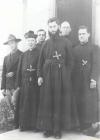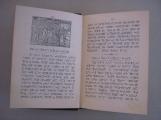1
The Old Catholic Mission at Heritage Park, Fort McMurray29 October 2009
Heritage Park, Fort McMurray, Alberta, Canada

2
Welcome to the Old Catholic Mission!The building now called the Old Catholic Mission was originally named the St Jean-Baptiste Mission, built in 1911. This was the first Catholic Church built in Fort McMurray. It is also the oldest building exhibited at Heritage Park.
As the backbone of Fort McMurray's Catholic community, the Old Catholic Mission housed the clergy and staff who served there until 1926. After the construction of the St. John the Baptist Roman Catholic Church, the administration moved out of the St. Jean-Baptiste Mission, but the quest to help those in need continued in the priests and laity who worked in this area.
Note that in this exhibit, the Mission building might be referred to as the St. Jean-Baptiste Mission, the St. John the Baptist Mission, or the Old Catholic Mission. Also, while the spelling "Athabasca" was officially adopted in the 1940s, the original spelling, "Athabaska," is still common and will be used in this storyline when referring to historical organizations or designations.
3
St. John the Baptist Mission (Old Catholic Mission) restoredcirca 1961
St. John the Baptist Mission, Fort McMurray, Alberta, Canada
 Credits:
Credits:Rev. Bernard Brown Collection
Fort McMurray Historical Society
4
Fort McMurray Before the MissionIn 1841, the Methodist Reverend James Evans passed through Fort McMurray, becoming the first missionary to set foot in the town. It was in 1847 that Father Alexandre Taché, while he was on his way to Fort Chipewyan, became the first recorded Catholic clergyman who visited Fort McMurray. On September 5th of that year, the first Mass was performed in Fort Chipewyan. Father Henry Faraud was the first priest permanently based in the Nativity Mission in Fort Chipewyan, beginning in 1849. At this time there was no priest stationed in Fort McMurray.
Before 1862, all Catholic missionaries in the north received their orders, called 'obediences,' from one bishop in St. Boniface, Manitoba. This changed when the Apostolic Vicariate of Athabaska-Mackenzie was established in 1862, with Bishop Faraud as the head of the region. Bishop Faraud then began issuing obediences. Fort McMurray was part of this Vicariate, and until it had its own mission, Fort Chipewyan's Nativity Mission served the community from a distance. Clergy used dog sleds, boats, or the missionaries' own two feet to travel to Fort McMurray and other towns and villages in the area. By 1880, there were twelve missions in the Vicariate, operated by twelve Oblate priests, seven Grey Nuns, and thirteen lay brothers. By 1901, the Vicariate was so large that it was split in two: Father Gabriel Breynat acted as Bishop of the Mackenzie Vicariate while Father Grouard became Bishop of the Athabaska Vicariate. Bishop Breynat operated out of Lac La Biche.
5
Fort Chipewyan Mission (postcard)circa 1914
Fort Chipewyan, Alberta, Canada
 Credits:
Credits:Katharine Richardson
Fort McMurray Historical Society
6
On Missionaries and OblatesAnyone travelling into north-western Canada at the end of the 1800s and the beginning of the 1900s found that they needed to take on a number of new and unexpected roles. The missionaries were no exception to this; they were often required to perform new tasks as different situations and emergencies arose. Because of their role in their communities and because of their dedication to serve them, they often became teachers, judges or arbitrators, social workers, translators and linguists, public lecturers, anthropologists, biblical scholars, carpenters and architects, fund-raisers, farmers, and physicians. Due to their working conditions, many were exhausted or ill before they could complete their obediences. Often, they were required by their superiors or by necessity to look after the local communities' physical survival on top of their spiritual well-being.
Oblate lay brothers often assisted the missionary priests. These men performed much of the manual labour so that the clergy could focus on ceremonial and pastoral concerns. The brothers did not have the institutional respect or privileges of the priests. However, they did often earn the community's thanks by constructing and maintaining the hospitals, schools, missions, boats, and other buildings that served them. Fort McMurray was no exception, as these brothers built both St. Gabriel's Hospital and St. John's Separate School.
The Missionary Oblates of Mary Immaculate (OMIs) are an organization originating in France. Their founder, Dr. Eugene Mazenod, grew up in the 18th century and witnessed his family's exile and separation during the French Revolution. He was ordained in 1811 and began ministry to the poor, attempting to restore religion's role in France after the Revolution's anti-Church purges. On this basis he founded the Oblates of Mary Immaculate in 1816, receiving recognition from Pope Leo XII in 1926. Though serving the poor was the order's initial aim, it soon expanded into a missionary order, specializing in "difficult missions," according to Pope Pius XI. Their first foreign mission was into Canada in 1841. The Oblates of Mary Immaculate, designated by an "OMI" after their names, have been important players in the development of Western Canada, providing not only spiritual guidance but financial assistance to the poor and to frontier communities with insufficient infrastructure.
Notice that an oblate lay brother holds a different position than the Oblates of Mary Immaculate. An oblate lay brother may or may not be affiliated with the OMI, and many members of the OMI are priests, not lay brothers. In this exhibit, oblate lay brothers are designated as 'lay brothers' to prevent confusion.
7
Group of Priests, including Father Gerard Chouinard1934-1947
Fort McMurray, Alberta, Canada
 Credits:
Credits:La Société Historique et Généalogique de Smoky River (The Smoky River Historical and Genealogical Society)
8
Building the MissionBy 1904 Father L. Croisé was permanently stationed in Fort McMurray. Fort McMurray's population rose to 312 people in 1911 and the Catholic Church approved the missionaries' request to build a mission in the community. At this point there was a problem: settlers and developers had claimed most of the land due to a sudden interest in the region's oil reserves. Bishop Grouard had not claimed any land and none was for sale in 1911. However, local landowner Alexander McDonald promised one acre of land and the mission construction went ahead on the basis of a handshake.
Bishop Grouard and Father L. Croisé began building on 29 May 1911 on River Lot #2, south of River Park Glen. This is near where the Grant McEwan Bridge crosses the Athabasca River today. Though informally called "The Old Mission," original documents refer to the structure as St. John the Baptist Mission or Saint Jean-Baptiste Mission. However, there is some evidence that "Sacred Heart Church" might have been another candidate for the name (see the photo of Real Martin for the story). Trees had previously been felled, brought down the river, and squared for the mission, but there were not enough, so Father Croisé sent labourers to get some more. Rain delayed the construction, but the exterior walls and the roof were finished by August. Father Croisé and his helper, Brother Leroux, then received obediences to go to Fort Chipewyan. They heard confession, distributed the annual $5 treaty payments to the First Nations people, and went north.
10
Father Laffont ArrivesFather Laffont OMI arrived in Fort McMurray in 1912, having been put in charge of the St. John the Baptist Mission. He left Fort Chipewyan on the SS Graham with Brothers Hemon, Leroux, and Bohan, and 2,000 feet of lumber. Brother Hemon's instructions were to make the Mission habitable, while Leroux was to meet the SS St. Joseph as it carried supplies to northern communities. When they arrived on 5 June 1912, they discovered that the HBC supply boats had not come, the SS St. Joseph had been stranded on the rocks of the Athabasca, the Mission had no remaining supplies, and the aboriginal people were waiting for them to distribute the treaty money. There was little food and no hardware to begin construction, and the HBC boat did not arrive for another three weeks. Once it did, they began their work: Brother Hemon began laying the floor and preparing the windows, Father Laffont heard confessions, and Brother Leroux went to help get the SS St. Joseph moving again.
Father Laffont and the brothers left for Fort Chipewyan in the winter, returning to Fort MacKay for Christmas and Fort McMurray for New Year's. At this time, Fort McMurray was considered a small hamlet compared to Forts MacKay and Chipewyan. Father Laffont returned again in the summer of 1913, this time on his own. Because he had no lay brothers with him, he was required to do the carpentry as well as perform his duties as a priest. For instance, he preached from an altar that he had built with discarded boards. He left again in the winter, and did not visit because his dog team was ill. In the summer of 1914 he returned and stayed permanently.
11
Father Adolphe Laffont1929-1960
 Credits:
Credits:La Société Historique et Généalogique de Smoky River (The Smoky River Historical and Genealogical Society)
12
The Mission OpensBrother Leroux fell ill in the summer of 1914 and was sent to Fort McMurray to recuperate. When he arrived, however, he did not get a chance to rest. Rather, he built a communion rail, two kneelers, a bed, and a steeple for their American-made church bell. Thanks to the work of Brother Leroux and Father Laffont, the mission officially opened that summer. Citizens of Fort McMurray attended Mass, weather permitting, and Father Laffont began keeping records of baptisms, deaths, and marriages. The first baptism was of Henry George Malcolm on 21 June.
At this time, Fort McMurray's citizens spoke a variety of languages. Father Laffont spoke English, French, Montagnais, Italian, Spanish, and Cree, and during his time in Fort McMurray he learned Chipewyan. A 1914 entry of the Mission Diary states, "There is also the fact that it is difficult to know in what language to give the sermon; as besides the English speaking listeners who are in the minority, the others are about approximately the same number. The Priest tried to speak in French and in Montagnais at Mass and one lesson in catechism in Cree during the rosary. On occasion the French sermon is replaced by a sermon in English; of course when a large number of Indians are at the mission everything is in their language."
13
St. John the Baptist Mission altar (postcard)1920s
St. John the Baptist Mission, Fort McMurray, Alberta, Canada
 Credits:
Credits:Real Martin
Fort McMurray Historical Society

